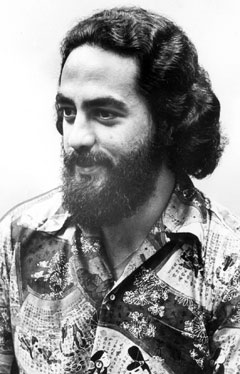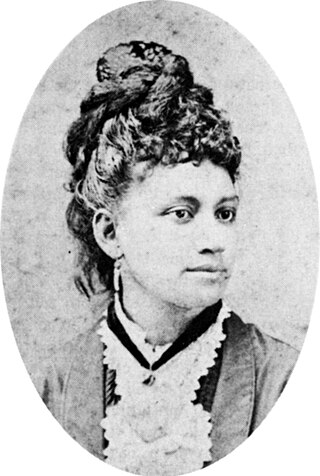Related Research Articles
The music of Hawaii includes an array of traditional and popular styles, ranging from native Hawaiian folk music to modern rock and hip hop. Styles like slack-key guitar are well known worldwide, while Hawaiian-tinged music is a frequent part of Hollywood soundtracks. Hawaii also made a contribution to country music with the introduction of the steel guitar. In addition, the music which began to be played by Puerto Ricans in Hawaii in the early 1900s is called cachi cachi music, on the islands of Hawaii.

Kalākaua, sometimes called The Merrie Monarch, was the last king and penultimate monarch of the Kingdom of Hawaiʻi, reigning from February 12, 1874, until his death in 1891. Succeeding Lunalilo, he was elected to the vacant throne of Hawaiʻi against Queen Emma. Kalākaua had a convivial personality and enjoyed entertaining guests with his singing and ukulele playing. At his coronation and his birthday jubilee, the hula, which had hitherto been banned in public in the kingdom, became a celebration of Hawaiian culture.

Louis Henri Jean Charlot was a French-born American painter and illustrator, active mainly in Mexico and the United States.

Mark Kealiʻi Hoʻomalu is a contemporary Hawaiian chanter, who was born and raised in ʻAiea, Oʻahu. He is best known for his contributions to the soundtrack of the 2002 Disney animated film, Lilo & Stitch, providing the film's two non-Elvis Presley-related songs. His style is both innovative and controversial, as purists disapprove of the liberties he takes in creating new arrangements of ancient chants.

George Jarrett Helm Jr. was a Native Hawaiian activist and musician from Kalama, Molokai, Hawaii. He graduated from St. Louis High School on Oahu in 1968. While at St. Louis, he studied under Hawaiian cultural experts John Keola Lake and Kahauanu Lake. In 1975, he joined the Hui Aloha ʻĀina organization on Molokai, and participated in the formation of the Protecting Kaho'olawe'auhana organization to end the U.S. Navy's bombing of the island. In 1976, he and nine activists occupied the island. On March 7, 1977, he left for Kaho'olawe and his whereabouts are unknown.

David Howard Hitchcock was an American painter of the Volcano School, known for his depictions of Hawaii.
Richard Kekuni Akana Blaisdell, was professor emeritus of medicine at the University of Hawaiʻi at Mānoa in Honolulu, and a longtime organizer in the Hawaiian Sovereignty Movement.

Hon Chew Hee was an American muralist, watercolorist and printmaker who was born in Kahului, on the Hawaiian island of Maui in 1906. He grew up in China, where he received his early training in Chinese brush painting. He returned to the United States in 1920 at age 14 in order to further his training at the San Francisco Art Institute, receiving that school's highest academic honor. He then taught in China until moving to Hawaii in 1935. In Hawaii, he worked as a freelance artist and held classes in both Western and Eastern styles of painting. Together with Isami Doi (1903–1965), Hee taught painting classes at the YMCA. At this time, Doi instructed the young artist in woodcarving techniques and Hee, like his master, created wood engravings drawn from the rural life in the Islands. Hee also founded the Hawaii Watercolor and Serigraph Society.

Juliette May Fraser was an American painter, muralist and printmaker. She was born in Honolulu, which was then the capital city of the Kingdom of Hawaii. After graduating from Wellesley College with a degree in art, she returned to Hawaii for several years. She continued her studies with Eugene Speicher and Frank DuMond at the Art Students League of New York and at the John F. Carlson School of Landscape Painting in Woodstock, New York. She returned to Hawaii to teach, like her parents who had both come to Hawaii as educators. Fraser designed the Hawaii Sesquicentennial half dollar, which was sculpted by Chester Beach and issued in 1928.

Uptown Oakland is a neighborhood in Oakland, California, located in the northern end of Downtown. It is located roughly between West Grand Avenue to the north, Interstate 980 to the west, City Center and 14th Street to the south, and Broadway to the east. The neighborhood has become an important entertainment district in recent years.

Thelma Beatrice Johnson Streat (1912–1959) was an African-American artist, dancer, and educator. She gained prominence in the 1940s for her art, performance and work to foster intercultural understanding and appreciation.
Marlene Mikahala Sai is a Hawaiian classic-style female solo singer, born in Honolulu of Hawaiian–Chinese heritage. The San Francisco Chronicle refers to Marlene Sai as one of the true icons of the islands. The Santa Cruz Sentinel refers to Sai as a living legend of Hawaiian music. PBS Hawaii's Leslie Wilcox says of Sai "There are only a handful of true divas in Hawaiian music, women who wrap their powerful voices with grace, elegance and beauty. You can add to the list Marlene Sai."
Juana Alicia is an American muralist, printmaker, educator, activist and, painter. She has been an educator for forty years. Juana Alicia, as part of the faculty Berkeley City College, founded and directed the True Colors Public Art program. Her sculptures and murals are principally located in the San Francisco Bay Area, Nicaragua, Mexico, Pennsylvania, and in many parts of California.

Elizabeth Sumner Chapman Achuck Lapana Keawepoʻoole was a Hawaiian high chiefess during the Hawaiian Kingdom and lady-in-waiting of Princess Likelike. An accomplished Hawaiian composer, she composed the popular Hawaiian love song Sanoe with Queen Liliʻuokalani, which was about a love affair in the Hawaiian royal court in the 1870s.

James Prigoff was an American photographer, author, and lecturer focusing on public murals, graffiti, and spraycan art. He has traveled extensively throughout the world documenting these art forms, and his personal archive of 100,000 slides may well be the most comprehensive of any individual mural and graffiti documentarian.
Terry Acebo Davis is a Filipino American artist and nurse based in the San Francisco Bay Area. Her art is thematically linked to her family and her origins as a Filipino American.

Kapaemahu refers to four stones on Waikīkī Beach that were placed there as tribute to four legendary mahu who brought the healing arts from Tahiti to Hawaiʻi centuries ago. It is also the name of the leader of the healers, who according to tradition, transferred their spiritual power to the stones before they vanished. The stones are currently located inside a City and County of Honolulu monument in Honolulu at the western end of Kuhio Beach Park, close to their original home in the section of Waikiki known as Ulukou. Kapaemahu is considered significant as a cultural monument in Waikiki, an example of sacred stones in Hawaiʻi, an insight into indigenous understandings of gender and healing and the subject of an animated film and documentary film.
Robert Edward Lin Nelson was a Hawaiian songwriter, composer, pianist, and singer. He is best known for his most popular songs, "Hanalei Moon" and "Maui Waltz". He was also a staunch defender of the copyrights and royalties of Hawaiian songwriters and composers, and served on advisory boards at ASCAP for two decades. In 2013 he received the Lifetime Achievement Award from the Hawaii Academy of Recording Arts.
Na Lani ʻEhā, translated as The Four Royals or The Heavenly Four, refers to the siblings King Kalākaua (1836–1891), Queen Liliʻuokalani (1838–1917), Princess Likelike (1851–1887) and Prince William Pitt Leleiohoku II (1854–1877). All four were composers, known for their patronage and enrichment of Hawaii's musical culture and history. All four of them organized glee clubs. William Pitt Leleiohoku II, the youngest brother who died at age 22, was a guitar master and leader of the Kawaihau Glee Club. Youngest sister Likelike was a musician and a co-founder of the Kaohuokalani Singing Club.
Nancy "Pili" Hernandez is an Irish Chicana interdisciplinary artist and activist. Her art often portrays climate injustices, with a key topic being water pollution. Her artwork is intended to promote changes in climate policy, and spread awareness about climate change.
References
- ↑ "About the Estria Foundation". Estria Foundation. May 14, 2020. Retrieved May 15, 2020.
- ↑ Archived October 14, 2009, at the Wayback Machine
- ↑ Swan, Rachel. "The Pecha Kucha PowerPoint Party | Events | Oakland, Berkeley & Bay Area". Eastbayexpress.com. Retrieved 2011-08-19.
- 1 2 Archived February 26, 2010, at the Wayback Machine
- ↑ "About the Estria Foundation". Estria Foundation. May 14, 2020. Retrieved May 14, 2020.
- ↑ "About Estria". Estria. May 14, 2020. Retrieved May 14, 2020.
- ↑ "Our History". Estria Foundation. Retrieved May 14, 2020.
- ↑ "Honolulu, Hawaii". Estria Foundation. Retrieved May 14, 2020.
- 1 2 Tamaira, A Mārata Ketekiri (2017). "Walls of Empowerment: Reading Public Murals in a Kanaka Maoli Context". The Contemporary Pacific. 29 (1): 1–35. doi:10.1353/cp.2017.0001. hdl: 10125/53881 . ISSN 1527-9464.
- ↑ Silva, Noenoe K. (2007). Aloha betrayed : native Hawaiian resistance to American colonialism. Duke University Press. ISBN 978-0-8223-3349-4. OCLC 838903287.
- ↑ Yukawa, Joyce; Harada, Violet H. (2009-06-14). "Librarian-Teacher Partnerships for Inquiry Learning: Measures of Effectiveness for a Practice-Based Model of Professional Development". Evidence Based Library and Information Practice. 4 (2): 97. doi: 10.18438/b8gg7k . ISSN 1715-720X.